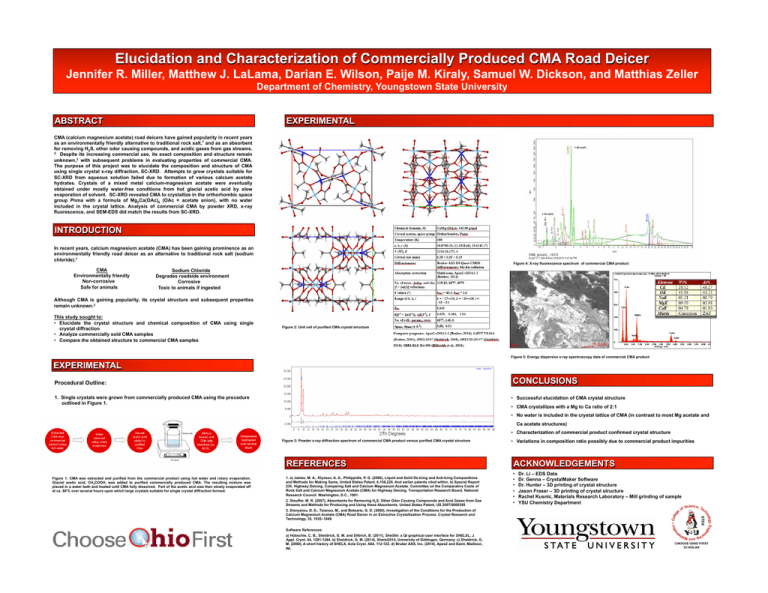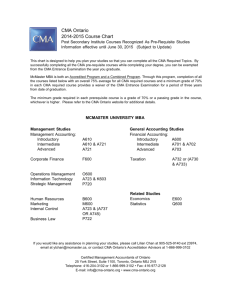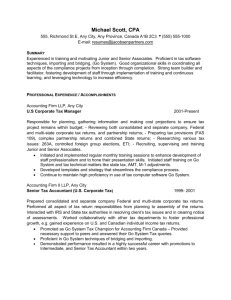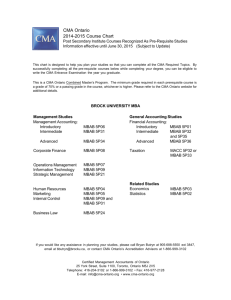Elucidation and Characterization of Commercially Produced CMA Road Deicer
advertisement

Elucidation and Characterization of Commercially Produced CMA Road Deicer Jennifer R. Miller, Matthew J. LaLama, Darian E. Wilson, Paije M. Kiraly, Samuel W. Dickson, and Matthias Zeller Department of Chemistry, Youngstown State University ABSTRACT EXPERIMENTAL CMA (calcium magnesium acetate) road deicers have gained popularity in recent years as an environmentally friendly alternative to traditional rock salt,1 and as an absorbent for removing H2S, other odor causing compounds, and acidic gases from gas streams. 2 Despite its increasing commercial use, its exact composition and structure remain unknown,3 with subsequent problems in evaluating properties of commercial CMA. The purpose of this project was to elucidate the composition and structure of CMA using single crystal x-ray diffraction, SC-XRD. Attempts to grow crystals suitable for SC-XRD from aqueous solution failed due to formation of various calcium acetate hydrates. Crystals of a mixed metal calcium-magnesium acetate were eventually obtained under mostly water-free conditions from hot glacial acetic acid by slow evaporation of solvent. SC-XRD revealed CMA to crystallize in the orthorhombic space group Pnma with a formula of Mg2Ca(OAc)6 (OAc = acetate anion), with no water included in the crystal lattice. Analysis of commercial CMA by powder XRD, x-ray fluorescence, and SEM-EDS did match the results from SC-XRD. 1.00 mol% 1.16 mol% INTRODUCTION In recent years, calcium magnesium acetate (CMA) has been gaining prominence as an environmentally friendly road deicer as an alternative to traditional rock salt (sodium chloride).1 CMA Environmentally friendly Non-corrosive Safe for animals Figure 4: X-ray fluorescence spectrum of commercial CMA product Sodium Chloride Degrades roadside environment Corrosive Toxic to animals if ingested Although CMA is gaining popularity, its crystal structure and subsequent properties remain unknown.3 This study sought to: • Elucidate the crystal structure and chemical composition of CMA using single crystal diffraction • Analyze commercially sold CMA samples • Compare the obtained structure to commercial CMA samples Figure 2: Unit cell of purified CMA crystal structure Figure 5: Energy dispersive x-ray spectroscopy data of commercial CMA product EXPERIMENTAL CONCLUSIONS Procedural Outline: 1. Single crystals were grown from commercially produced CMA using the procedure outlined in Figure 1. • Successful elucidation of CMA crystal structure • CMA crystallizes with a Mg to Ca ratio of 2:1 • No water is included in the crystal lattice of CMA (in contrast to most Mg acetate and Ca acetate structures) • Characterization of commercial product confirmed crystal structure Figure 3: Powder x-ray diffraction spectrum of commercial CMA product versus purified CMA crystal structure Figure 1: CMA was extracted and purified from the commercial product using hot water and rotary evaporation. Glacial acetic acid, CH3COOH, was added to purified commercially produced CMA. The resulting mixture was placed in a water bath and heated until CMA fully dissolved. Part of the acetic acid was then slowly evaporated off at ca. 80°C over several hours upon which large crystals suitable for single crystal diffraction formed. • Variations in composition ratio possibly due to commercial product impurities REFERENCES ACKNOWLEDGEMENTS 1. a) James, M. A., Klyosov, A. A., Philippidis, P. G. (2000), Liquid and Solid De-Icing and Anti-Icing Compositions and Methods for Making Same. United States Patent. 6,156,226. And earlier patents cited within. b) Special Report 235. Highway Deicing. Comparing Salt and Calcium Magnesium Acetate. Committee on the Comparative Costs of Rock Salt and Calcium Magnesium Acetate (CMA) for Highway Deicing. Transportation Research Board. National Research Council. Washington, D.C., 1991. • • • • • • 2. Stouffer, M. R. (2007), Absorbents for Removing H2S, Other Odor Causing Compounds and Acid Gases from Gas Streams and Methods for Producing and Using these Absorbents. United States Patent, US 2007/0000385 3. Dionysiou, D. D., Tsianou, M., and Botsaris, G. D. (2000), Investigation of the Conditions for the Production of Calcium Magnesium Acetate (CMA) Road Deicer in an Extractive Crystallization Process. Crystal Research and Technology, 35, 1035–1049. Software References: a) Hübschle, C. B., Sheldrick, G. M. and Dittrich, B. (2011), ShelXle: a Qt graphical user interface for SHELXL, J. Appl. Cryst. 44, 1281-1284. b) Sheldrick, G. M. (2014), Shelxl2014, University of Göttingen, Germany. c) Sheldrick, G. M. (2008), A short history of SHELX, Acta Cryst. A64, 112-122. d) Bruker AXS, Inc. (2014), Apex2 and Saint, Madison, WI. Dr. Li – EDS Data Dr. Genna – CrystalMaker Software Dr. Hunter – 3D printing of crystal structure Jason Fraser – 3D printing of crystal structure Rachel Kusnic, Materials Research Laboratory – Mill grinding of sample YSU Chemistry Department





